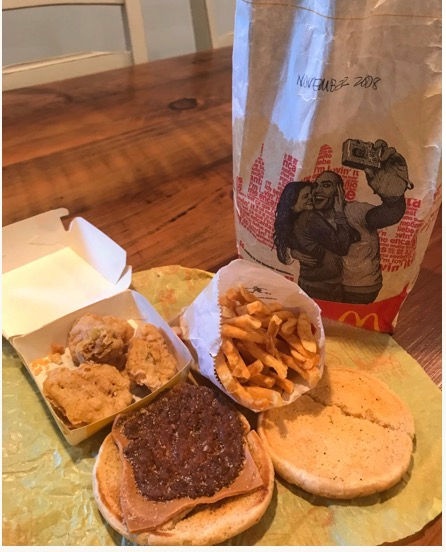
There may be many excuses for you to head to the drive-thru more often than you might care to admit: a hectic workday, cranky kids, an afternoon of errands, a simple craving for comfort food. And while the fact that fast food is bad for us isn’t a secret, the taste and convenience can seem like a fair trade on busy days—especially if it’s not a regular habit.
Back in November 2008, I purchased a plain cheeseburger, small fries, and a small order of chicken nuggets from McDonald’s. I left the bag of “food” in the trunk of my car for three days, then brought it into the house to see what would happen. Nearly 10 years later, only two things have changed: the discoloration of the grease on the bag and all three items are rock solid. Otherwise, there’s no mold, bugs, decay, or color change—all things that are supposed to happen with food. And if this isn’t enough to get you to rethink even the occasional fast food meal, here are ten more reasons you’ll want to leave the drive-thru in your rearview mirror.
Its Health Effects Are Immediate For a long time, it was believed that the negative health effects of fast food were cumulative, and that so long as you exercised moderation, the occasional trip through the drive-thru wouldn’t do much harm. However, just one meal can narrow your arteries and increase blood pressure, increase inflammation, and cause a surge in insulin leaving you tired, cranky, and hungry.
It’s Not Really Meat There are plenty of jokes about the “mystery meat” that is fast food, and it turns out there’s truth in jest. In general, fast-food chicken contains “about a quarter less protein” than home-cooked and has sodium levels seven to ten times higher than the unprocessed stuff. When it comes to Subway, their chicken only contained 50 percent chicken and the rest was soy. As far as those chicken nuggets? Research has shown that they’re mostly composed of fat, bone, nerve, and connective tissue. Disgusting.
It’s Full of Antibiotics With very few exceptions, fast food meat is factory farmed—meaning the animals are packed into tight, dirty spaces, fed the cheapest food possible, and because of the highly unsanitary conditions, are pumped full of antibiotics to keep them alive. A whopping 16 out of 25 fast food chains scored an “F” rating in antibiotic use, while only Panera Bread and Chipotle scored an “A.” Remember what your protein eats, you eat, too.
It May Be Carcinogenic While not yet proven, those fast food French fries may very well up your cancer risk due to the acrylamide that develops as a result of the deep-frying process. While the National Toxicology Program considers acrylamide “reasonably anticipated to be a human carcinogen” based on studies conducted on mice and rats, more research is necessary to determine its exact effect on humans. Either way, avoid exposure to chemicals that cause cancer in animals. Better safe than sorry is always my motto.
Its Packaging Is Toxic The bags, wrappers, and other packaging associated with fast food contain harmful chemicals known as per- and polyfluoroalkyl substances, known as PFAS, which are used to keep grease from seeping out onto your hands and clothing. These synthetic chemicals easily leach into food and do not break down in the body—meaning they can accumulate over time and adversely affect your health. The Environmental Protection Agency (EPA) lists low infant birthweight, cancer, thyroid hormone disruption, and immune system complications as possible side effects of long-term exposure.
It Can Contain High Fructose Corn Syrup (HFCS) and Artificial Sweeteners Hopefully, you’ve heard how too much sugar—especially HFCS—can adversely affect your health. Associated risks of HFCS include obesity, diabetes, hypertension, and heart disease, while artificial sweeteners like aspartame, sucralose, and saccharine can also cause heart disease and lead to weight gain, migraines, and Type 2 diabetes. Don’t be fooled into thinking sweeteners are just in the obvious stuff, like sodas and desserts. You’ll find them in virtually everything on the fast food menu, including buns, dressings, and savory sauces.
It Can Also Contain Artificial Dyes and Preservatives Speaking of the unnatural, fake sugars aren’t the only chemicals lurking in your fast food. Preservatives and artificial dyes, like Red #40, Yellow #5, and Blue #1 are linked to a variety of health problems, such as behavioral issues in children like ADHD, as well as migraines and allergies, and are banned in the UK. You’ll find dyes and preservatives in virtually every menu item, especially colorful milkshakes and those black hamburger buns on Halloween.
It Can Leave You with a Splitting Headache Suffer from migraines? MSG, short for monosodium glutamate, is a common flavor enhancer—and migraine trigger. While Chinese food is the most recognized culprit, MSG is found in many fast food items and can cause both regular and migraine headaches, nausea, breathing issues, changes in heart rate, and in especially sensitive people, burning sensations in the forearms and neck.
It Can Wreak Havoc on Your Skin No matter your age, no one likes having acne. According to the Mayo Clinic, refined carbohydrates, which are a big component of fast food, trigger blood sugar spikes that send your oil glands into overdrive, leading to breakouts. In turn, the healthier you eat, the less pimples you’ll see.
It Can Increase Inflammation Most fast food restaurants use refined oils such as canola, which can also be partially hydrogenated to increase its shelf life. Refined oils are highly inflammatory to the body, and chronic inflammation can lead to weight gain, cancer, arthritis, and heart disease—among other debilitating issues.
You can take back your health by first cutting fast foods out of your diet and learning how to incorporate healthy, whole foods that help fight disease. The more you practice healthy habits, the more successful you’ll be at replacing the unhealthy ones. Need help creating a healthy eating structure? Contact me, I’m here to help.

Comments